For a long time, pond owners have been trying to save money on their electrical bill. The recommended turnover rate for a pond is once per hour minimum. Twice per hour is better. In order to get a 1 hour turnover on a 20,000 gallon pond, you would need four 1/4hp Centrifugal pumps. At around 330 watts each, the combined wattage of those pumps would be 1320, using the electrical calculator, those pumps would cost you $91 a month to operate...OUCH.
Centrifugal pumps are nice, if you need a low to medium head pressure application like a waterfall, but a 20,000 gallon waterfall would be overkill. So one pump for the waterfall would be fine, and the other 16,000gph we could return back to the pond via a Tangental Pond Return (TPR). This type of application would be very low pressure 1-3". The perfect pump for this job would be a Propeller Pump or Axial Flow Pump. These pumps basically look just like a trolling motor. A Pump with a propeller on it.
My first experiments were with a 12V Trolling motor from a boat. Nice flow, low electrical cost but how to run the 12Volts, how to do the plumbing, etc... As we discussed this on the on-line forum community, a fellow by the name of Luke Frisbee from Florida had been experimenting with a lake de-icer pump on his 50,000 gallon pond. He purchased a 1/20hp Ice Eater from The Power House Inc.. This pump is meant to be used in the winter to keep ice from forming on the surface. The pump is rated at 172 watts, and pushes 17,000gph (25lbs of thrust). Luke posted this picture on one of the on-line forums, and got my wheels spinning:
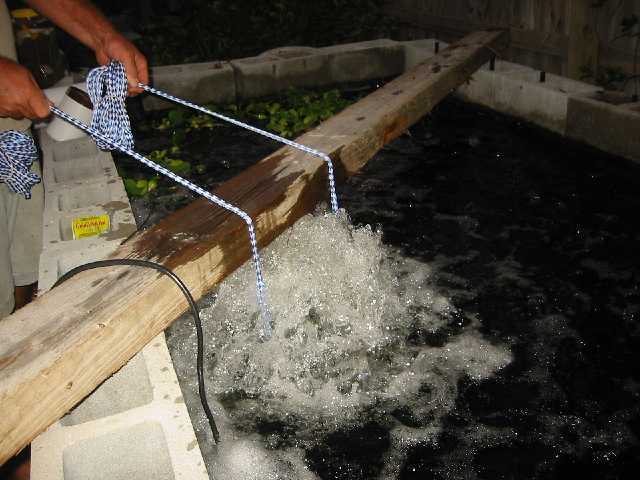
In July 2005 I immediately purchased one of these pumps for ($400) and began my own testing. I took the ropes and the shroud off. I turned the shroud upside down (which made it stick out the front longer. I also cut the bottom off a bucket and mounted it on. I did this to simulate the pump pushing through a 10" pipe. Since the bucket even flairs at the front, it was more like 11".
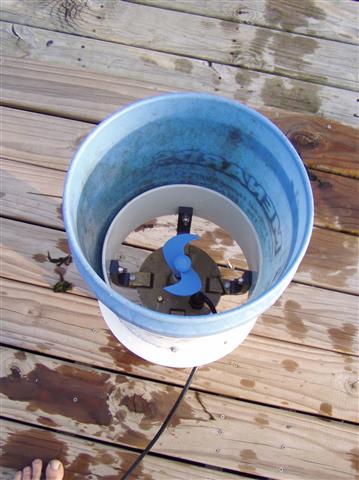
I mounted the pump by some ropes and tested in the same way that Luke had done.
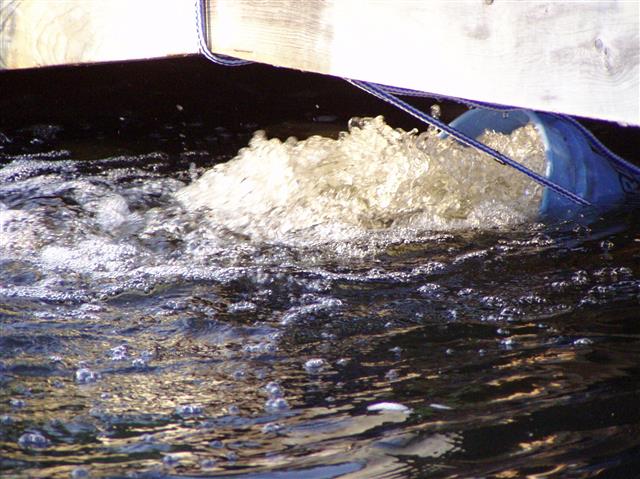
I held the pump in the water and tested the flow at various angles. Completely submerged it pushed an amazing amount of water. At 24" down, it was still strong enough to create a whirlpool at the surface. WOW. I pointed it toward the far wall of the narrow width of the pond, and got a real good current going (24' to the other edge). The pond started swirling in 2 huge circles. One clockwise, one counter clockwise. The koi started comming up to swim in this current and were having a great time.
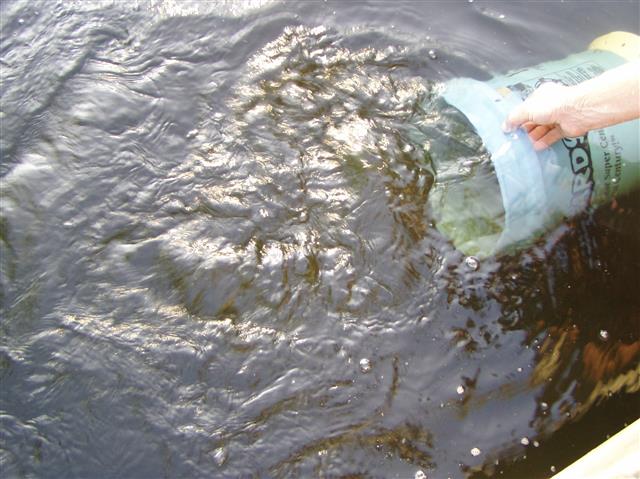
At a slight angle to the surface, still moves alot of water, but not as much as before.
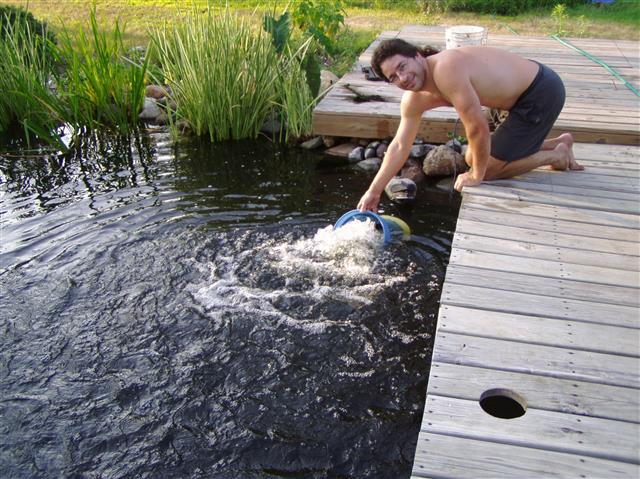
Next test was to get flow up and over a wall. I went over to the breeding pond, and put the pump in the settling chamber, and angled the flow up and over back to the pond. Got some splashing over but not much. It was about a 3" wall to go over. This is not how the pump would be mounted anyway, but wanted to try it out.
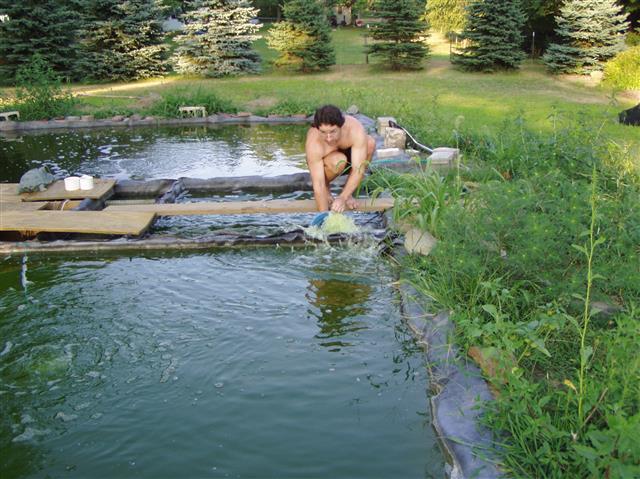
So now on to a more scientific approach with a practicle appliction. Since 10" pipe is not that common, I changed the mounting brackets and mounted the pump to a 6" pipe:
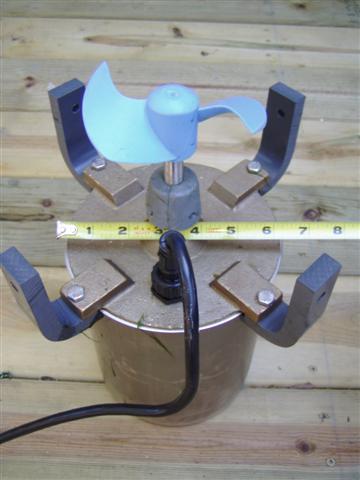
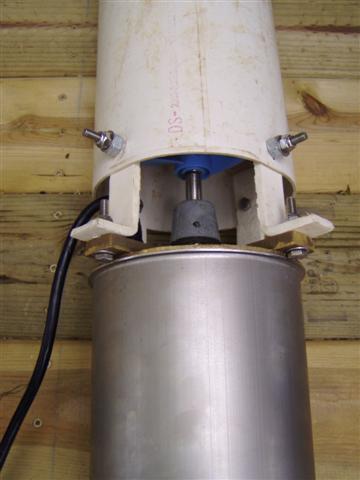
Put the unit back in the pond and tested the flow. I would say it now gets half of the flow it did at the 10" size, however, it is able to pump the water a little higher (maybe 3"). 6" shutoff. Mounted it about 3' down in the pond and I am getting great flow from it, but with the 10" was better. In this picture pump is mounted vertically, and the pipe ends about 2" below water level. I would say the plum was at least 3", and full 6" diameter or more.
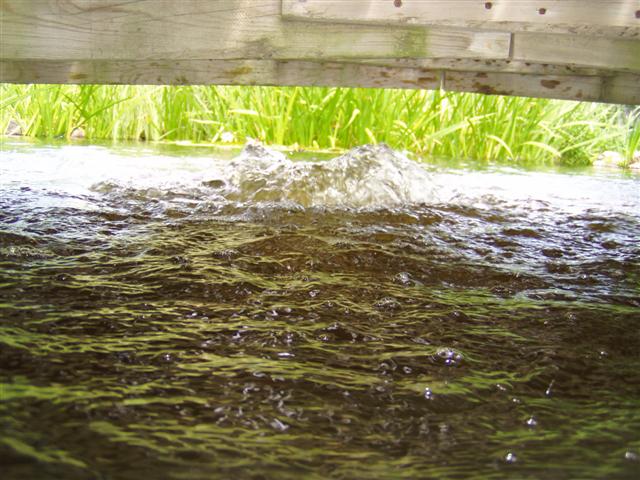
Next I set up a test pond. Here's the specs....
Settling chamber 2x4x18" (90 gallons)
Pond 4x6x18" (270 gallons)
Six 4" side ports (simulated bottom drains)
One 6" output back to pond.
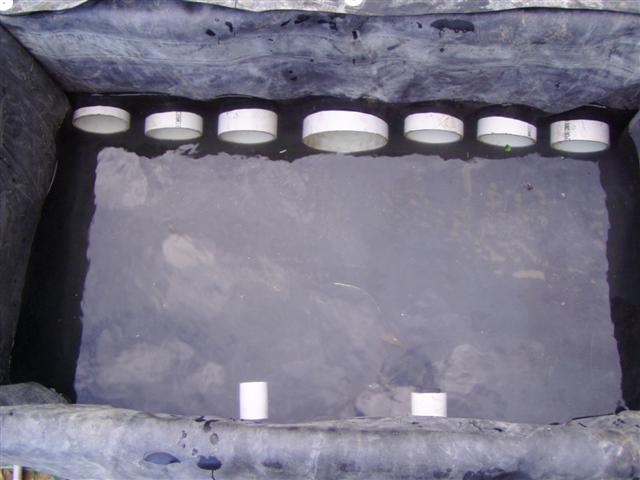
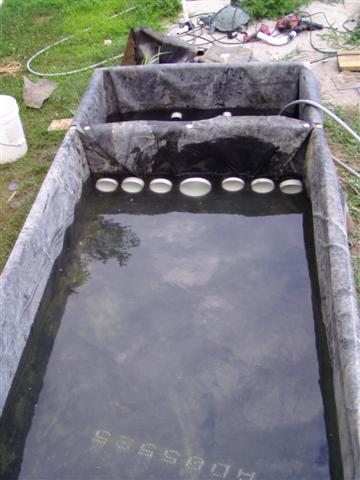
Ice-eater pump mounted
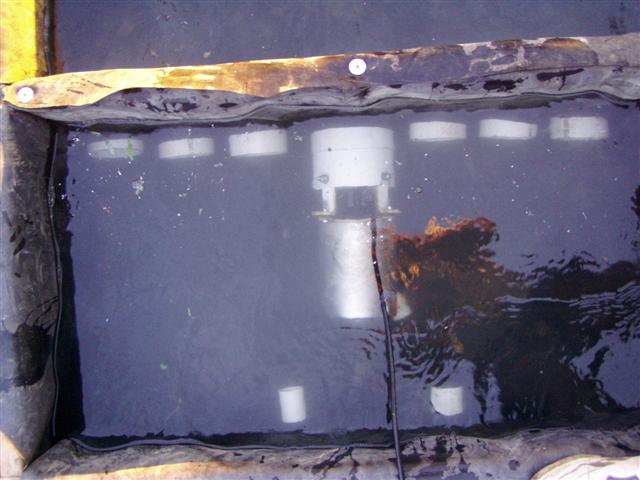
Baseline water level at the 4 1/2" mark.
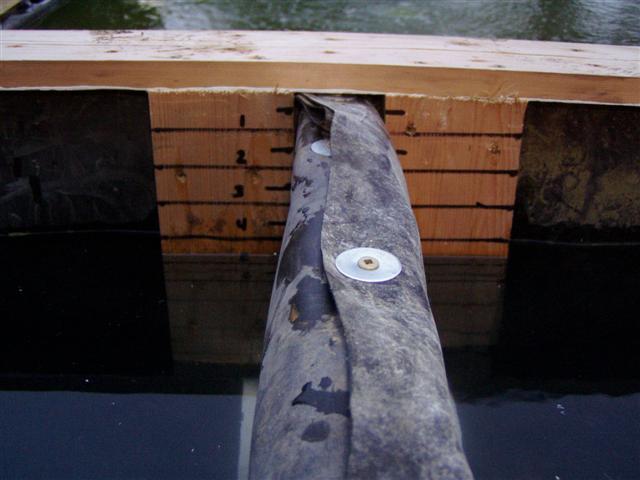
Ice eater in operation, full flow, all drains open. Drawdown in chamber with six 4" drains 1/4" (water level at the 4 3/4" mark). FLOW AWSOME
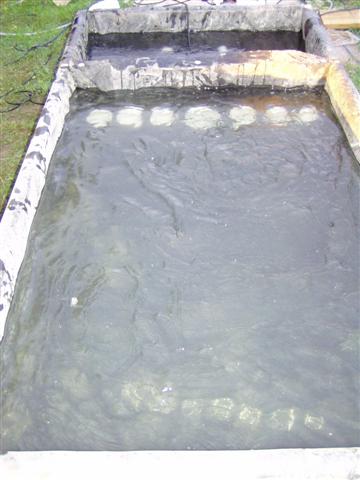
5 drains open. Drawdown in chamber 3/8" (water level at the 4 7/8" mark). FLOW STILL AWSOME
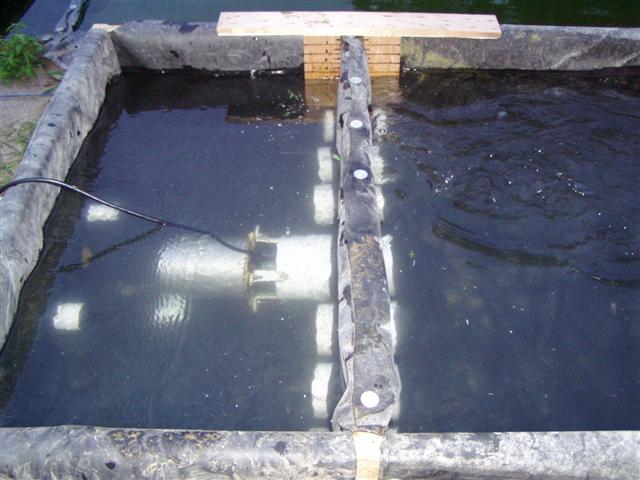
4 drains open. Drawdown in chamber 1/2" (water level at the 5" mark). FLOW STILL AWSOME
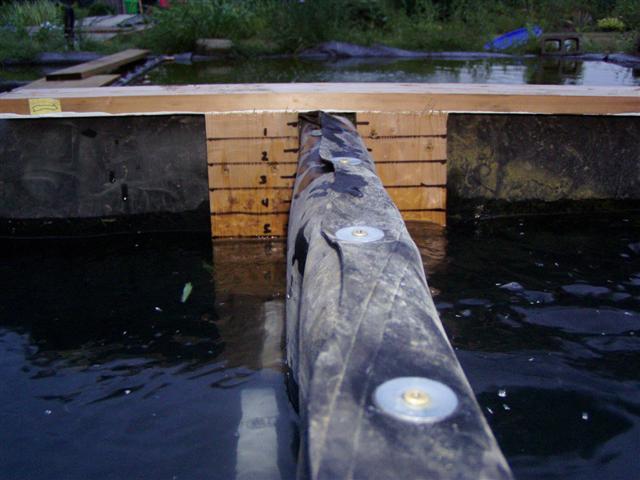
3 drains open. Drawdown in chamber 3/4" (water level at the 5 1/4" mark). FLOW STILL AWSOME
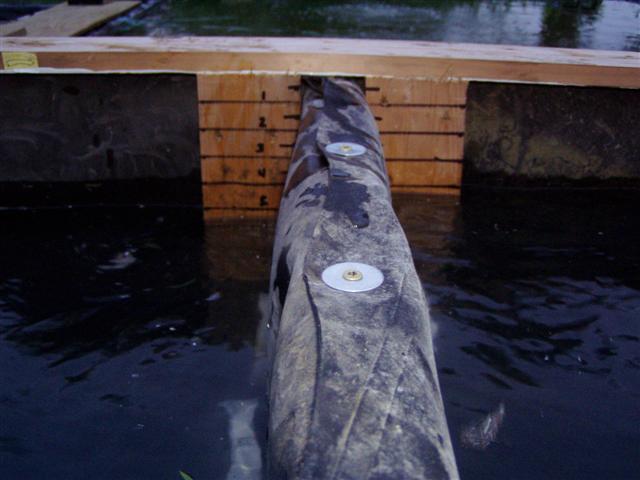
2 drains open. Drawdown in chamber 1 1/2" (water level at the 6" mark). FLOW STILL AWSOME
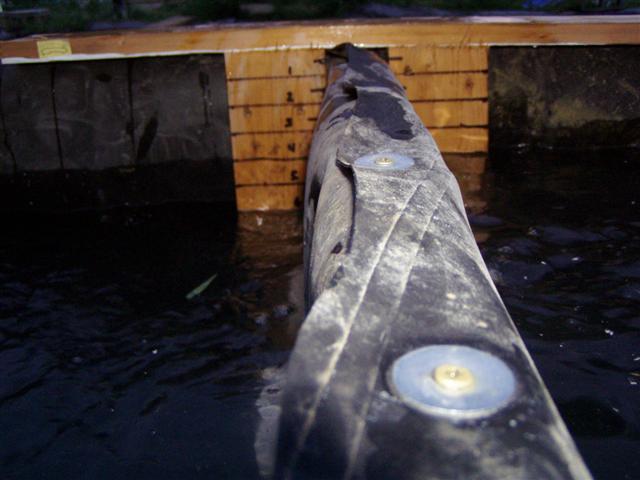
1 drain open. Drawdown in chamber 2 1/2" (water level at the 7" mark). FLOW GOOD, BUT WAVERING. At 1 drain open, the pump appeared to start loosing against the pressure, the drawdown in the chamber would fluctuate about 3/4" back and forth.
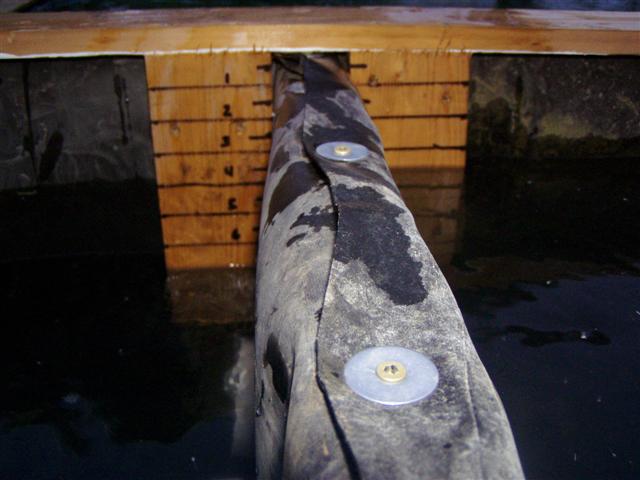
I call that a very successful test, and am very excited about remodeling my filter system to accommodate this new pump. I added an extension on to the output of the pump. It did not seem to affect the flow, but did help get rid of the spiraling energy, and have more liner energy. I placed a plastic peice in front of the pipe (like a rudder) and it also did the same thing.
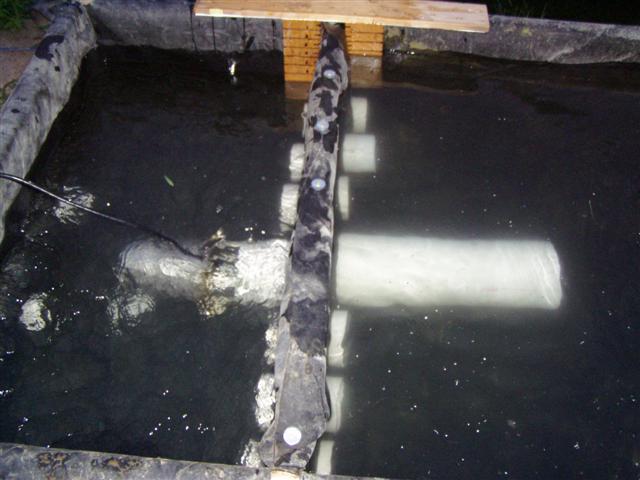
Ok, now, to be truely scientific, I ran this same test with a known volume pump.
First off, one Sequence 1000, 4400gph.
6 drains - 0" draw-down
5 drains - 0" draw-down
4 drains - 0" draw-down
3 drains - 0" draw-down
2 drains - 1/8" draw-down
1 drains - 5/8" draw-down (picture shown)
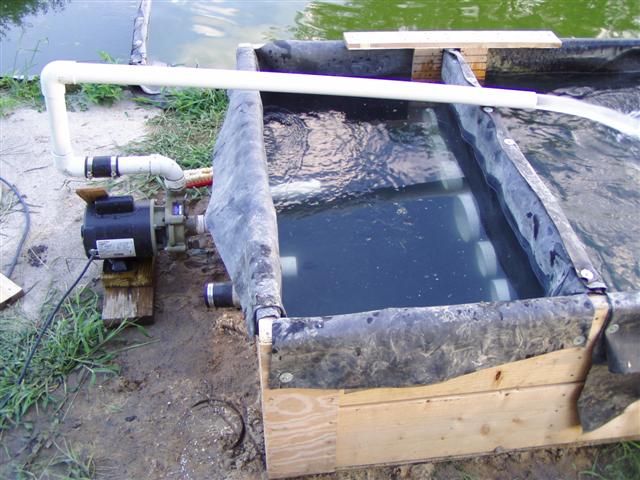
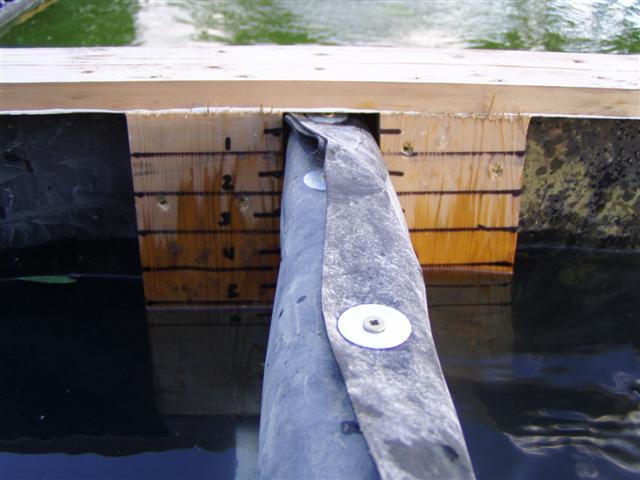
Next up, the Sequence 1000 (4400gph) and a Sequence 750 (3600gph). Total flow 8000gph.
6 drains - 0" draw-down
5 drains - 0" draw-down
4 drains - 0" draw-down
3 drains - 1/4" draw-down
2 drains - 1/2" draw-down
1 drains - 1" draw-down (picture shown)
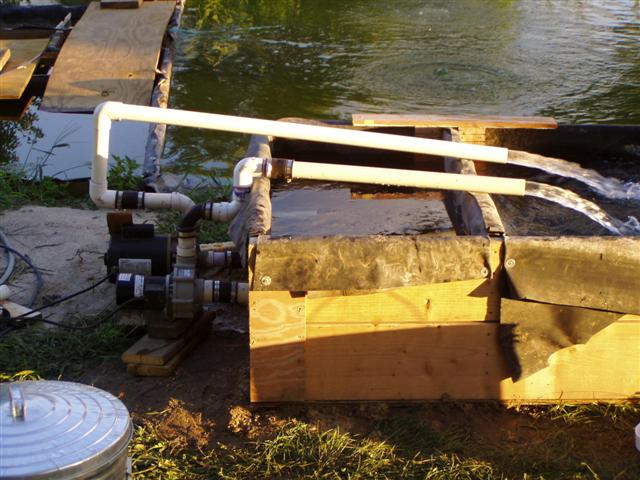
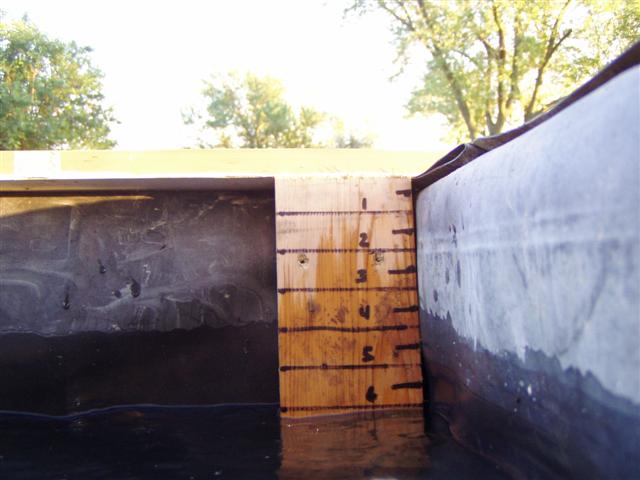
Proof is in the pudding, the Ice-Eater pump BLOWS AWAY the competition. I feel confident that if I added a third sequence pump (total of 12400gph) that the draw-down would still not equal that of the Ice-Eater. I even think that 4 sequence pumps would be needed to equal the flow of one Ice-Eater. Thats 17,600gph folks. Here is a chart showing the draw-down curve of the 3 tests.
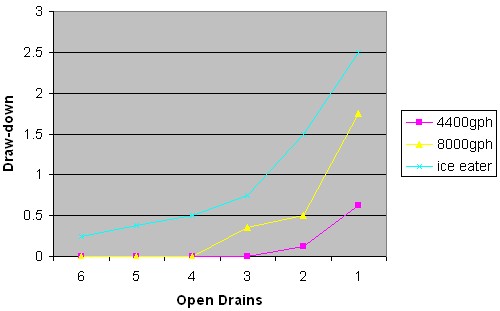
If you follow the 3000gph gravity flow rate rule for a 4" pipe, then that means that a 4400gph Sequence needs one 4" drains. Since the draw-down on 2 drains was only 1/8", and there are 6 drains, we could presume that three Sequence pumps (13200gph) would only have a 1/8" draw down if all drains were open (thats half of the draw-down that the ice-eater had when all of its drains were open). If we look at the test data, we can see that with 4 of the drains open there was no draw-down for 8000gph which would support that conclusion. With 3 drains open there was a 1/4" draw down for 8000gph, so if the flow were increased to 16,000gph and all drains were open, the total draw-down should still be 1/4".
I would say that the "Gallons Per Minute 291.4" (17,484gph) that the Powerhouse had given on its website is pretty darn accurate.
Took my ice eater pump down to my neighbors mud pond last night and gave him a demo of the flow. His pond is about 170 by 100. Set it up under the dock (far end of the pond, upper left in picture). The pump was about 24" below the surface and pointed toward the curve. It only took a couple of minutes, and the pump started circulating the pond to where we could see the surface of the pond moving very slow. The entire half of the pond was rotating. Creating some very nice flow. Leaves and dust which were on the pond were moving. Even his duck decoys were spinning around.
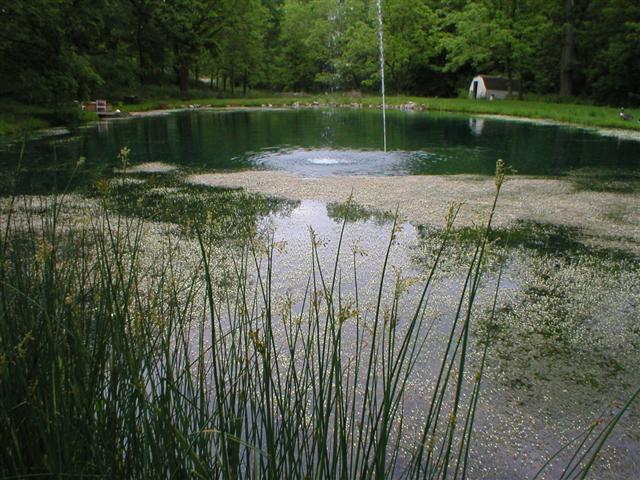
So, testing complete, and I am very satisfied with this pump. I put it into production in my 8,000 gallon pond in my koihouse.. It runs four 4" bottom drains, and two 4" no-niche style skimmers. It gives me a 30 minute turnover rate.
If this pump is too big for you, check out the SEIO.